GREETINGS FROM EARTH! Welcome to my space blog! Let's explore the stars together!!!
144 posts
Latest Posts by littlecadet-biguniverse - Page 3

Spiral galaxy NGC 4911 in the Coma Cluster
js

Night Sky Over Mt. Fuji - Jan. 2016
js

ESO 378-1


Jupiter’s North Pole Unlike Anything Encountered in Solar System
NASA’s Juno spacecraft has sent back the first-ever images of Jupiter’s north pole, taken during the spacecraft’s first flyby of the planet with its instruments switched on. The images show storm systems and weather activity unlike anything previously seen on any of our solar system’s gas-giant planets. “First glimpse of Jupiter’s north pole, and it looks like nothing we have seen or imagined before,” said Scott Bolton, principal investigator of Juno from the Southwest Research Institute in San Antonio. “It’s bluer in color up there than other parts of the planet, and there are a lot of storms. There is no sign of the latitudinal bands or zone and belts that we are used to – this image is hardly recognizable as Jupiter. We’re seeing signs that the clouds have shadows, possibly indicating that the clouds are at a higher altitude than other features.”
Credit: NASA/JPL-Caltech/SwRI/MSSS

Just Another Milky Way Shot Taken From Death Valley, CA
js

Into the storm


Rho Ophiuchi

Galaxy Trio Arp 286:
NGC 5566 (bottom), NGC 5569 (left), & NGC 5560 (center)
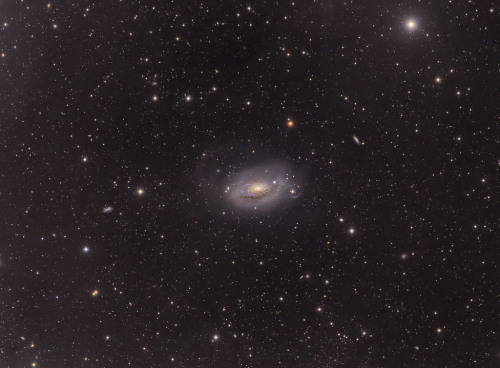
M63 // Sunflower Galaxy
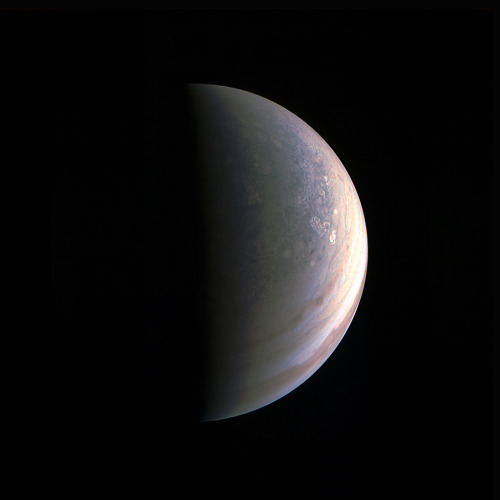
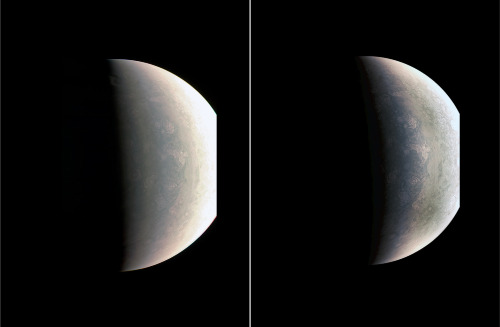
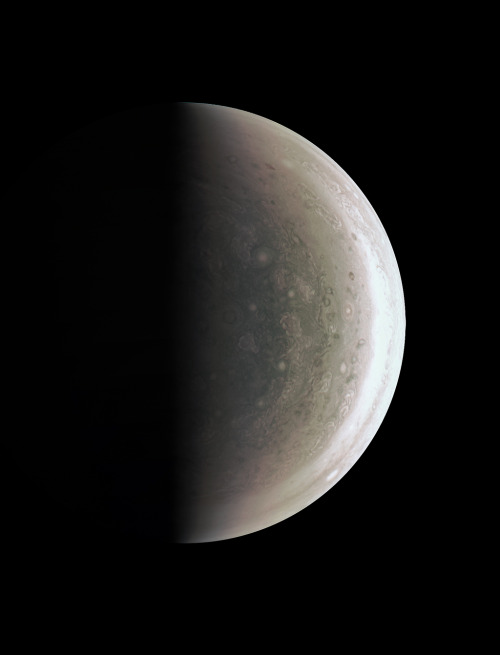
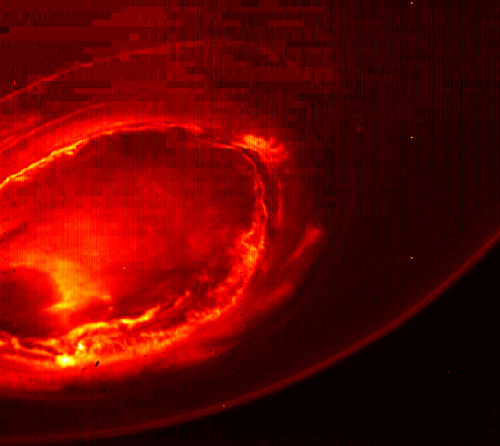
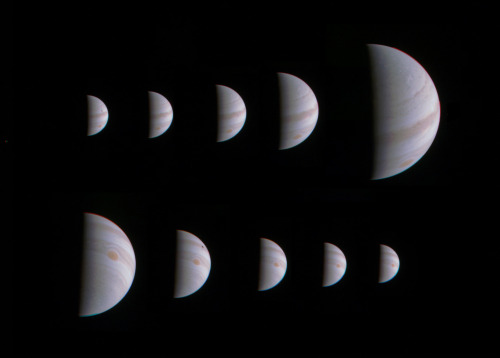
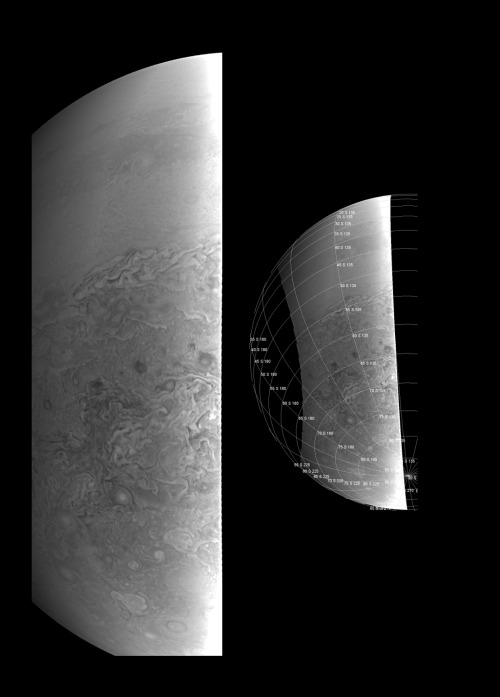
Jupiter’s North Pole Unlike Anything Encountered in Solar System
NASA’s Juno spacecraft has sent back the first-ever images of Jupiter’s north pole, taken during the spacecraft’s first flyby of the planet with its instruments switched on. The images show storm systems and weather activity unlike anything previously seen on any of our solar system’s gas-giant planets.
Juno successfully executed the first of 36 orbital flybys on Aug. 27 when the spacecraft came about 2,500 miles (4,200 kilometers) above Jupiter’s swirling clouds. The download of six megabytes of data collected during the six-hour transit, from above Jupiter’s north pole to below its south pole, took one-and-a-half days. While analysis of this first data collection is ongoing, some unique discoveries have already made themselves visible.
“First glimpse of Jupiter’s north pole, and it looks like nothing we have seen or imagined before,” said Scott Bolton, principal investigator of Juno from the Southwest Research Institute in San Antonio. “It’s bluer in color up there than other parts of the planet, and there are a lot of storms. There is no sign of the latitudinal bands or zone and belts that we are used to – this image is hardly recognizable as Jupiter. We’re seeing signs that the clouds have shadows, possibly indicating that the clouds are at a higher altitude than other features.”
One of the most notable findings of these first-ever pictures of Jupiter’s north and south poles is something that the JunoCam imager did not see.
“Saturn has a hexagon at the north pole,” said Bolton. “There is nothing on Jupiter that anywhere near resembles that. The largest planet in our solar system is truly unique. We have 36 more flybys to study just how unique it really is.”
Along with JunoCam snapping pictures during the flyby, all eight of Juno’s science instruments were energized and collecting data. The Jovian Infrared Auroral Mapper (JI-RAM), supplied by the Italian Space Agency, acquired some remarkable images of Jupiter at its north and south polar regions in infrared wavelengths.
“JIRAM is getting under Jupiter’s skin, giving us our first infrared close-ups of the planet,” said Alberto Adriani, JIRAM co-investigator from Istituto di Astrofisica e Planetologia Spaziali, Rome. “These first infrared views of Jupiter’s north and south poles are revealing warm and hot spots that have never been seen before. And while we knew that the first ever infrared views of Jupiter’s south pole could reveal the planet’s southern aurora, we were amazed to see it for the first time. No other instruments, both from Earth or space, have been able to see the southern aurora. Now, with JIRAM, we see that it appears to be very bright and well structured. The high level of detail in the images will tell us more about the aurora’s morphology and dynamics.”
Among the more unique data sets collected by Juno during its first scientific sweep by Jupiter was that acquired by the mission’s Radio/Plasma Wave Experiment (Waves), which recorded ghostly- sounding transmissions emanating from above the planet. These radio emissions from Jupiter have been known about since the 1950s but had never been analyzed from such a close vantage point.
“Jupiter is talking to us in a way only gas-giant worlds can,” said Bill Kurth, co-investigator for the Waves instrument from the University of Iowa, Iowa City. “Waves detected the signature emissions of the energetic particles that generate the massive auroras which encircle Jupiter’s north pole. These emissions are the strongest in the solar system. Now we are going to try to figure out where the electrons come from that are generating them.”
The Juno spacecraft launched on Aug. 5, 2011, from Cape Canaveral, Florida and arrived at Jupiter on July 4, 2016. JPL manages the Juno mission for the principal investigator, Scott Bolton, of Southwest Research Institute in San Antonio. Juno is part of NASA’s New Frontiers Program, which is managed at NASA’s Marshall Space Flight Center in Huntsville, Alabama, for NASA’s Science Mission Directorate. Lockheed Martin Space Systems, Denver, built the spacecraft. Caltech in Pasadena, California, manages JPL for NASA.
IMAGE 1….As NASA’s Juno spacecraft closed in on Jupiter for its Aug. 27, 2016 pass, its view grew sharper and fine details in the north polar region became increasingly visible. The JunoCam instrument obtained this view on August 27, about two hours before closest approach, when the spacecraft was 120,000 miles (195,000 kilometers) away from the giant planet (i.e., for Jupiter’s center). Unlike the equatorial region’s familiar structure of belts and zones, the poles are mottled with rotating storms of various sizes, similar to giant versions of terrestrial hurricanes. Jupiter’s poles have not been seen from this perspective since the Pioneer 11 spacecraft flew by the planet in 1974.
IMAGE 2….Storm systems and weather activity unlike anything encountered in the solar system are on view in these color images of Jupiter’s north polar region from NASA’s Juno spacecraft. Two versions of the image have been contrast-enhanced differently to bring out detail near the dark terminator and near the bright limb. The JunoCam instrument took the images to create this color view on August 27, when the spacecraft was about 48,000 miles (78,000 kilometers) above the polar cloud tops. A wavy boundary is visible halfway between the grayish region at left (closer to the pole and the nightside shadow) and the lighter-colored area on the right. The wavy appearance of the boundary represents a Rossby wave – a north-south meandering of a predominantly east-west flow in an atmospheric jet. This may be caused by a difference in temperature between air to the north and south of this boundary, as is often the case with such waves in Earth’s atmosphere. The polar region is filled with a variety of discrete atmospheric features. Some of these are ovals, but the larger and brighter features have a “pinwheel” shape reminiscent of the shape of terrestrial hurricanes. Tracking the motion and evolution of these features across multiple orbits will provide clues about the dynamics of the Jovian atmosphere. This image also provides the first example of cloud shadowing on Jupiter: near the top of the image, a high cloud feature is seen past the normal boundary between day and night, illuminated above the cloud deck below. While subtle color differences are visible in the image, some of these are likely the result of scattered light within the JunoCam optics. Work is ongoing to characterize these effects.
IMAGE 3….This image from NASA’s Juno spacecraft provides a never-before-seen perspective on Jupiter’s south pole. The JunoCam instrument acquired the view on August 27, 2016, when the spacecraft was about 58,700 miles (94,500 kilometers) above the polar region. At this point, the spacecraft was about an hour past its closest approach, and fine detail in the south polar region is clearly resolved. Unlike the equatorial region’s familiar structure of belts and zones, the poles are mottled by clockwise and counterclockwise rotating storms of various sizes, similar to giant versions of terrestrial hurricanes. The south pole has never been seen from this viewpoint, although the Cassini spacecraft was able to observe most of the polar region at highly oblique angles as it flew past Jupiter on its way to Saturn in 2000
IMAGE 4….This infrared image gives an unprecedented view of the southern aurora of Jupiter, as captured by NASA’s Juno spacecraft on August 27, 2016. The planet’s southern aurora can hardly be seen from Earth due to our home planet’s position in respect to Jupiter’s south pole. Juno’s unique polar orbit provides the first opportunity to observe this region of the gas-giant planet in detail. Juno’s Jovian Infrared Auroral Mapper (JIRAM) camera acquired the view at wavelengths ranging from 3.3 to 3.6 microns – the wavelengths of light emitted by excited hydrogen ions in the polar regions. The view is a mosaic of three images taken just minutes apart from each other, about four hours after the perijove pass while the spacecraft was moving away from Jupiter.
IMAGE 5….This montage of 10 JunoCam images shows Jupiter growing and shrinking in apparent size before and after NASA’s Juno spacecraft made its closest approach on August 27, 2016, at 12:50 UTC. The images are spaced about 10 hours apart, one Jupiter day, so the Great Red Spot is always in roughly the same place. The small black spots visible on the planet in some of the images are shadows of the large Galilean moons. The images in the top row were taken during the inbound leg of the orbit, beginning on August 25 at 13:15 UTC when Juno was 1.4 million miles (2.3 million kilometers) away from Jupiter, and continuing to August 27 at 04:45 UTC when the spacecraft was 430,000 miles (700,000 kilometers) away. The images in the bottom row were obtained during the outbound leg of the orbit. They begin on August 28 at 00:45 UTC when Juno was 750,000 miles (920,000 kilometers) away and continue to August 29 at 16:45 UTC when the spacecraft was 1.6 million miles (2.5 million kilometers) away.
IMAGE 6….This image provides a close-up view of Jupiter’s southern hemisphere, as seen by NASA’s Juno spacecraft on August 27, 2016. The JunoCam instrument captured this image with its red spectral filter when the spacecraft was about 23,600 miles (38,000 kilometers) above the cloud tops. The image covers an area from close to the south pole to 20 degrees south of the equator, centered on a longitude at about 140 degrees west. The transition between the banded structures near the equator and the more chaotic polar region (south of about 65 degrees south latitude) can be clearly seen. The smaller version at right of this image shows the same view with a latitude/longitude grid overlaid. This image has been processed to remove shading effects near the terminator – the dividing line between day and night – caused by Juno’s orbit.

47 Tucanae
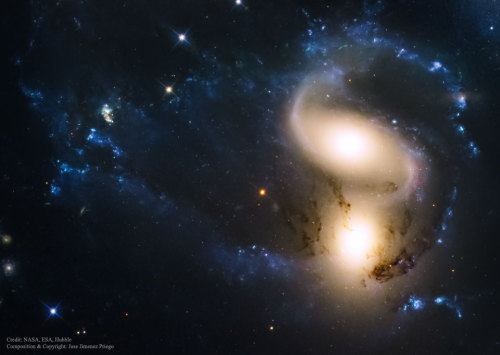
Colliding Galaxies NGC 7318, part of Stephan’s Quintet
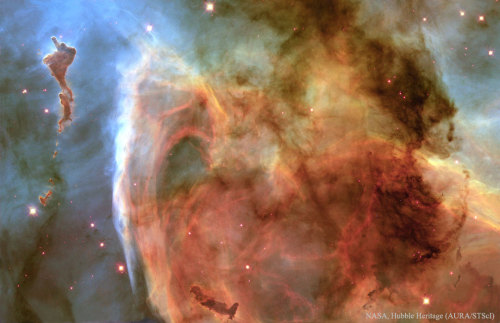
Keyhole Nebula, inside the larger Carina Nebula
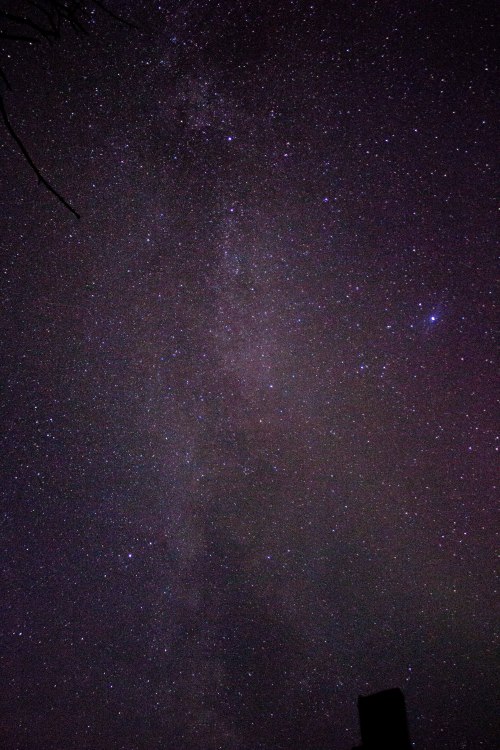
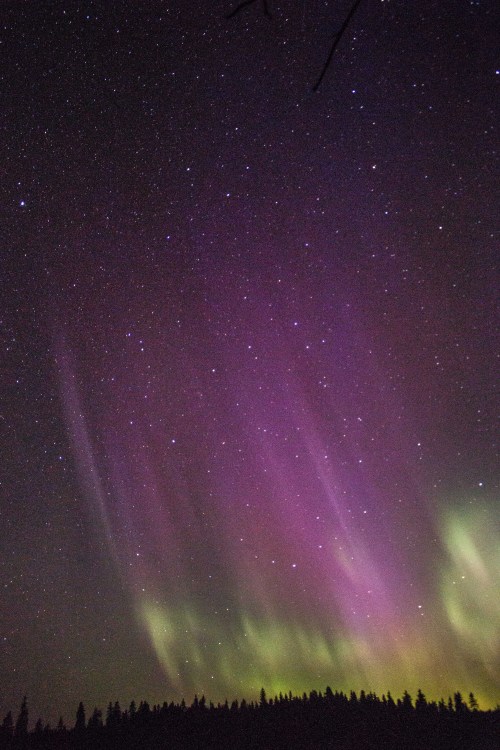
Northern lights over Nyrölä, Finland. My cousin called me last night and said “There’s no clouds over the Central Finland and it’s very dark.”. And so we drove at midnight 30 miles out of the city to get these photographs. It was magical. -Eero

Milky Way from Lake Cuyamaca js


Mercury is passing directly across the sun for the first time in nearly a decade.
The innermost planet of our solar system will look like a small, dark circle cutting across the sun’s disc. In the U.S., the transit began shortly after 7 a.m. ET on Monday and will continue for more than seven hours.
At least part of the transit, which only happens about 13 times every century, will be visible across the Americas, Europe, Africa and large portions of Asia.
If you’re hoping to watch it, eye protection is key. NASA stresses that “viewing this event safely requires a telescope or high-powered binoculars fitted with solar filters made of specially-coated glass or Mylar.”
You won’t be able to see the tiny dot of Mercury on its celestial crawl without magnification, NASA says.
Another option: Check out one of the multiple live-streaming events going on Monday. NASA says it will stream the transit here, here and here.
It’s not all about the show — transits like this one have historically been, and continue to be, important research opportunities for scientists. First observed in 1631, the transits were later used to “measure the distance between the Earth and the Sun,”NASA said.
Now, they provide scientists an opportunity to study the planets’ exospheres — the thin layer of gases that make up their atmosphere.
“When Mercury is in front of the sun, we can study the exosphere close to the planet,” NASA scientist Rosemary Killen said in a release from the Jet Propulsion Laboratory. “Sodium in the exosphere absorbs and re-emits a yellow-orange color from sunlight, and by measuring that absorption, we can learn about the density of gas there.”
Additionally, scientists have found that a transiting planet causes a drop in the sun’s brightness.
This phenomenon is “the main way we find planets outside the solar system,” NASA says.
The Kepler mission, which is searching for habitable planets, has found 1,041 planets to date using the transit method. The mission says it is able to determine the size of a planet by observing its transit.
Image Credit: NASA


Helix Nebula in Visible and in Infrared Light
The Helix Nebula, also known as NGC 7293, is a large planetary nebula (PN) located in the constellation Aquarius. Planetary nebulae like the Helix are sculpted late in a Sun-like star’s life by a torrential gush of gases escaping from the dying star. They have nothing to do with planet formation, but got their name because they look like planetary disks when viewed through a small telescope.
Credit: ESO/VISTA/J. Emerson.

Solar surges are cool jets of plasma ejected in the solar atmosphere from chromospheric into coronal heights. This particular surge has been captured in a loopy structure and streamed sunwards along the magnetic field lines.
Surges are associated with active regions and they are most likely triggered by magnetic reconnection and magnetohydrodynamic (MHD) wave activity. According to their morphological features, surge prominences can be classified into three types: jet-like, diffuse, and closed loop (above). Jet-like and diffuse surges are associated with coronal mass ejections (CMEs), but the closed-loop surges are not because the initial acceleration of the eruption is slowed down and finally stopped by the overlying coronal loops.
Credit: SDO/ LMSAL

Solar filaments a.k.a. prominences – when observed at the solar limb (above), are long clouds of partially ionized plasma suspended above the Sun’s surface by strongly sheared magnetic structures, called filament channels, that can support the dense plasma against solar gravity. Filaments may form at various locations on the Sun, however, they are always found within preexisting filament channels above polarity inversion lines which separate areas of opposite magnetic polarity regions.
Credit: NASA/SDO/LMSAL

Milky Way js

North American Nebula js

Milky Way over Shelbyville, Indiana
js

Infrared VISTA view of a stellar nursery in Monoceros
js

Panorama from the Apollo 15 mission

a night with the stars will usually help
By: Jonah Reenders

Island Point Milky Way
Nikon d5100 - 6 x 25s - ISO 4000 - f2.8 - 16mm

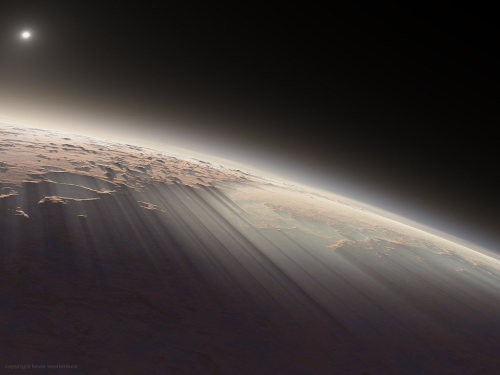
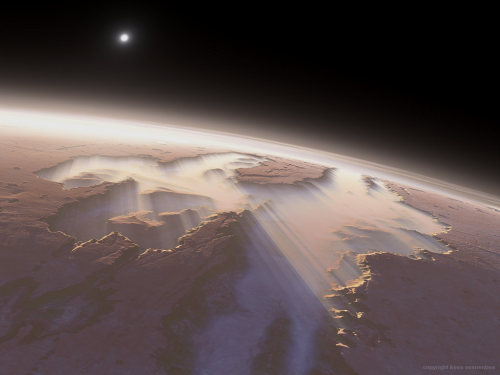


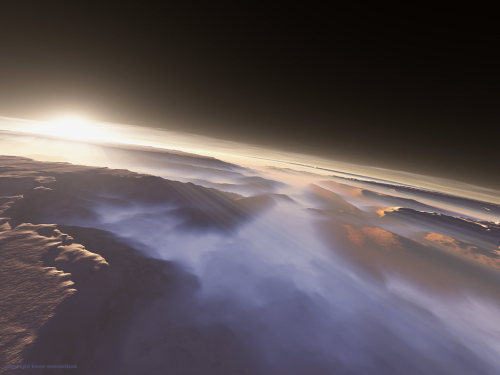
Morning On Mars
Martian sunrises, as seen by the HiRISE orbiter

Uranus’ icy moon Miranda wowed scientists during the Voyager encounter with its dramatically fractured landscapes.
via reddit